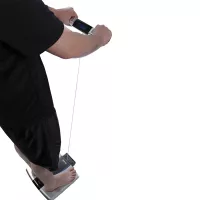Bathroom scales that calculate body fat have been around for over 20 years. Tanita in fact introduced the world’s first body fat scale for home use in 1994. These scales use a process called bioelectric impedance analysis (BIA) technology. BIA sends a very low, safe electrical signal through the body using electrodes attached to the skin, held, or stood on. The signal passes quickly through water that present in hydrated muscle tissue but meets resistance when it hits fat tissue. This resistance, known as impedance, is measured and input into scientifically validated equations to calculate body composition.
Up until just recently, all consumer scales utilizing BIA employed a single electrical scan. For example, a 50 kHz alternating current was used to measure impedance and then complete the calculations. The measured impedance along with other factors such as age, gender and height is then entered into the equations. And while this is widely acknowledged as providing accurate measurements, clinical research revealed that the addition of a second frequency would further enhance the accuracy.
For many years, Tanita has employed dual and multi frequency BIA technology on professional BIA analyzers. High and low frequencies interact differently with the body’s cellular structure, and therefor provide the ability to discriminate the condition both inside and outside the cell wall. Combining the results of these scans allows the analyzer to perform a more in-depth and analysis, improving the accuracy, and providing additional analysis.
Now consumers can benefit from the same increased level of analysis found in professional models using multiple BIA frequencies. Tanita has several models using the very latest dual frequency BIA technology. These include the RD-901plus, the RD-953, the RD-945IM and the BC-1500plus. In addition to the enhanced accuracy, many of these models also have exciting new features like muscle quality and standing heart rate, along with radio wireless connectivity.



Comments